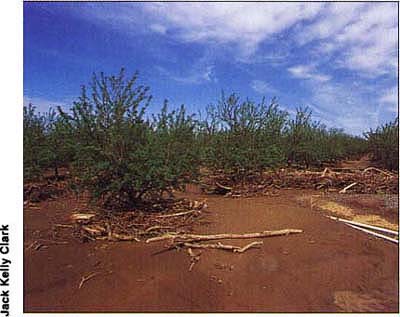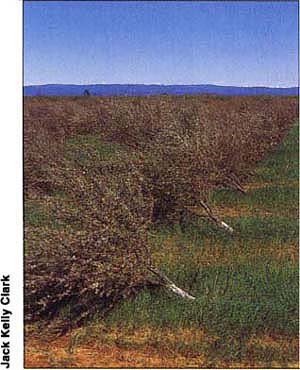All Issues
March was the cruelest month
Publication Information
California Agriculture 49(3):6-6.
Published May 01, 1995
PDF | Citation | Permissions
Full text
T.S. Eliot may have thought April was the cruelest month, but this year Californians would probably disagree. March brought a series of destructive storms, prompting Gov. Wilson to declare a state of emergency in 48 of the 58 counties.
The storm damage was widespread, toppling trees, washing away topsoil, drowning field and nursery crops and putting the brakes on fruit and nut development. Almond growers may have been dealt the hardest blow. Gusts clocked at up to 60 miles per hour uprooted about 1 million almond trees from rain-softened orchard floors throughout the Central Valley.
The Consolidated Farm Service Agency has received 2,900 emergency conservation claims to help pay for clean up of debris left behind by the storms, land leveling and other structural repairs.
“For some growers it's absolutely devastating,” said Blue Diamond Growers spokesman David Baker. “Growers who lost 30 to 40% of their orchards may find it economically difficult to recover.” Unlike row crops, almond trees take four years after planting to produce and several more years to reach full production. However, he noted that the 14,000 acres of uprooted trees account for only 2 to 3% of total almond tree acreage. The major reason production is expected to fall, he said, is that the overcast skies reduced bee activity substantially during bloom, and cool, rainy postbloom weather stopped nut development.
Accurately figuring the cost of storm damage is difficult. For example, the California Department of Food and Agriculture (CDFA) estimates almond losses at $198.5 million, while Blue Diamond's estimate is just over $100 million. The smaller 1995 crop will cause prices to be higher, offsetting some losses.
Total crop and livestock losses from the storms were estimated at $651.6 million by CDFA on April 25 in its final report. In contrast, January flooding only caused an estimated $97 million of damage to agriculture.
Losses vary depending on the crop's production stage at the time the damage occurred. The Salinas and Pajaro rivers overran their banks in the vegetable-growing region of Monterey County, turning California's “salad bowl” into soup. CDFA estimated the cost at $241 million. However, a crop that was ready to harvest is a bigger loss than one just planted. Quickly replanting a crop in short supply, such as lettuce, could minimize the loss. Further, supply disruptions typically result in high market prices particularly for perishable crops like lettuce.
Thus, farmers whose fields are unaffected may be able to sell their crops at a high price. In this case, even some of the growers with damaged crops may come out ahead because a 50% crop loss can be more than recouped by a price increase greater than 50%.
Even crops like cotton that weren't in the ground suffered setbacks from the weather. Flooding creeks washed away beds prepared for planting and in some cases deposited 4 to 6 feet of silt on fields, which will require releveling. Money spent on preirrigation, bedding up, fertilizer and pesticides was lost. In Monterey County fields where rushing water washed away 2 to 2.5 feet of topsoil, the effects extend beyond this year because the hardpan that's left is not suitable for growing crops.
The federal Consolidated Farm Service Agency, by April 25, had already received 1,481 claims statewide under its new crop insurance and disaster aid program (see page 7 ). Two-thirds of the claims are catastrophic losses, which are being processed. However, the other 500 claims fall under the non-insured assistance program (NAP) for which the regulations are still being written. “We can't process NAP claims until the regulations are finalized,” said agency spokesperson Robert Molleur, “but we're inspecting damage and we brought in four extra adjusters to help assess damage in a timely manner.”
-Editor






